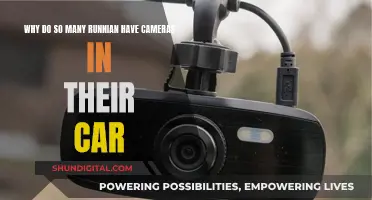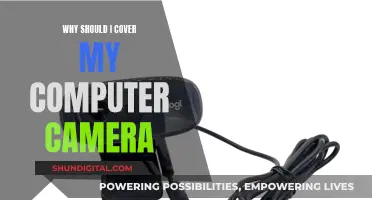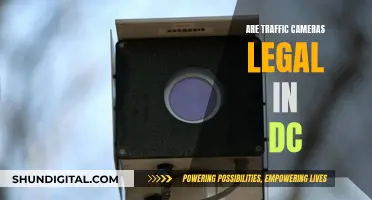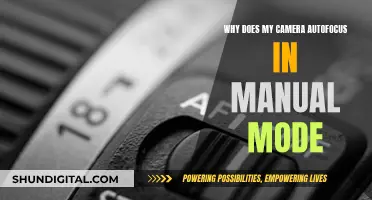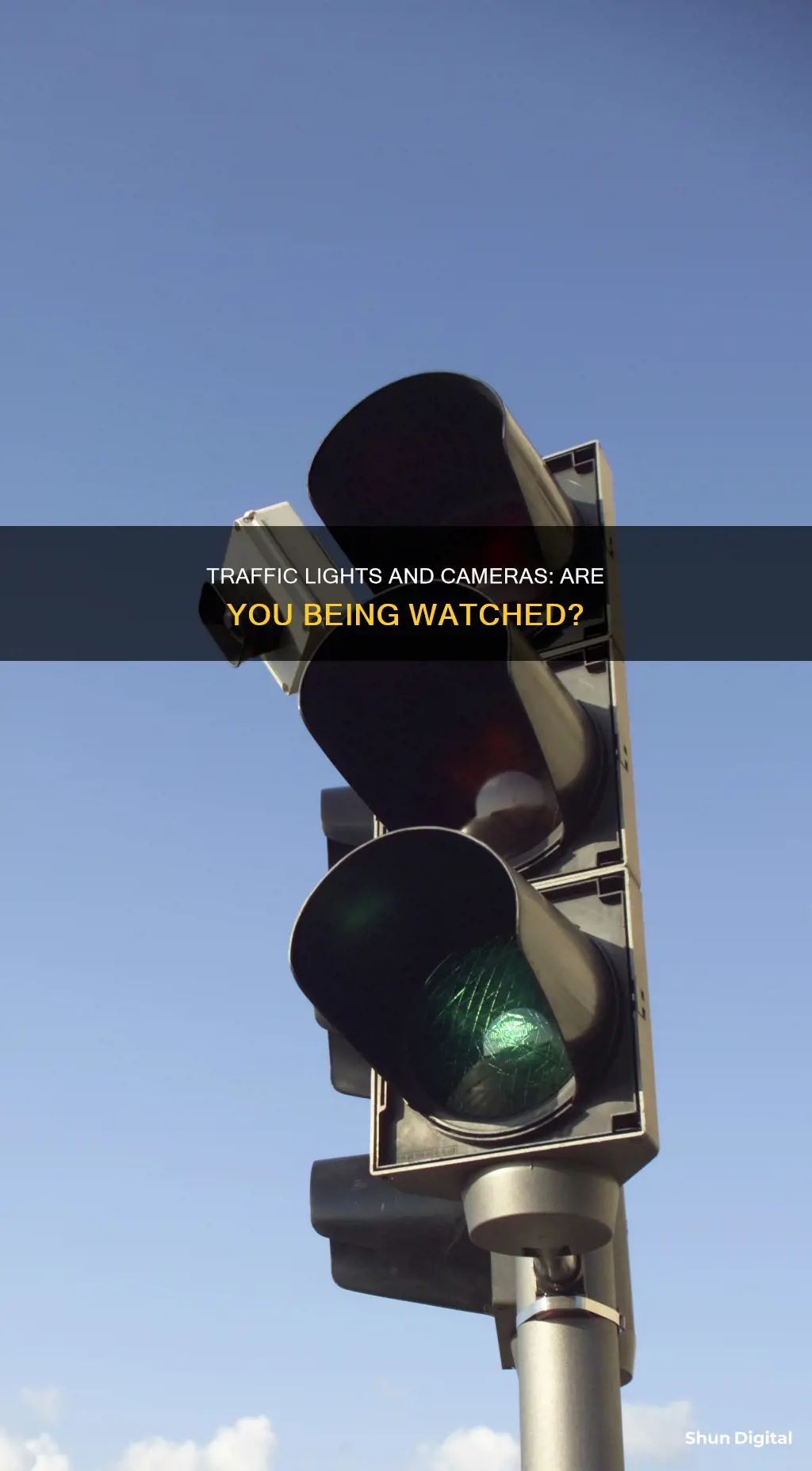
Traffic signals often have cameras attached to them, and these are typically used to monitor and manage traffic flow. These cameras are usually small and cylindrical or dome-shaped, enclosed in weatherproof housing, and are often mounted on top of traffic signals or high on light poles above roadways. They are not used for issuing tickets or violations but instead help to measure traffic flow and determine traffic light timing. While these cameras do not generally archive video, the footage can, in rare cases, be used as evidence in car accident claims.
However, some cameras on traffic signals are red-light enforcement cameras, which are used to enforce traffic laws and issue tickets to drivers who run red lights. These cameras are usually bulkier and consist of a large camera box and two external flashes, often mounted on separate poles.
| Characteristics | Values |
|---|---|
| Purpose | To monitor and manage traffic at busy crossings, detect vehicles, and enforce road safety |
| Camera Type | Red-light cameras, traffic monitoring cameras, video imaging systems, closed-circuit TV cameras, etc. |
| Mounting | On traffic light poles or mounted high on light poles above roadways |
| Functionality | Detect vehicles, monitor traffic flow, provide live stream/real-time video, capture images/video evidence of traffic violations, adjust signal timing, etc. |
| Use by Authorities | Used by police, traffic engineers, and law enforcement agencies for traffic management and enforcement |
| Data and Evidence | May record details such as date, time, location, vehicle speed, time since the light turned red, etc. |
| Privacy Concerns | Some argue that cameras violate privacy and are used more for financial gain than public safety |
What You'll Learn
- Traffic signal cameras are often confused with red-light cameras
- Cameras on traffic signals are usually white and monitor traffic flow through intersections
- Red-light cameras are placed before intersections to capture red-light violations
- Red-light cameras are controversial, with opponents arguing they are used for financial gain
- Traffic signal cameras are also used to detect the presence of emergency vehicles

Traffic signal cameras are often confused with red-light cameras
Another distinction is their purpose. Red-light cameras are automated ticket-issuing systems that capture multiple images of the car during a violation. These images can be used as evidence for potential traffic violations. In contrast, traffic signal cameras are not tied to any enforcement system and are primarily used to measure traffic flow and determine traffic light timing. The video from these cameras is generally not archived or used for incident reconstruction.
It is worth noting that red-light cameras are often placed at busy intersections to improve road safety by deterring motorists from running red lights. They are usually positioned separately from the traffic signal, whereas traffic signal cameras are installed directly on top of the traffic signal or pole. This difference in location can help identify the type of camera in use.
While red-light cameras actively enforce traffic laws, traffic signal cameras play a passive role in monitoring and managing traffic flow. They help adjust signal timing to optimise traffic flow and reduce congestion. This distinction in functionality is another key factor that differentiates these two types of cameras.
Unlocking Privacy Shutter on Lenovo Camera: A Step-by-Step Guide
You may want to see also

Cameras on traffic signals are usually white and monitor traffic flow through intersections
Traffic signals often have cameras installed, and these are typically small, white, and dome-shaped. These cameras are usually traffic monitoring cameras, which are owned by the relevant department of transportation. They are not red-light cameras, and they do not record footage that can be retrieved later. Instead, they exist to help the flow of traffic and provide a live stream used by traffic engineers, law enforcement, cities, and counties. These cameras are usually installed on top of traffic signals or mounted high on light poles above roadways.
These cameras are part of a video imaging system that uses low-resolution cameras to detect the presence of cars. A "zone" is drawn within the camera's view, and the system monitors the number of waiting cars stopped at a light. When there is a specified change in the number of vehicles, the camera notifies the signal to change its lights.
While these cameras do not record footage, the relevant department of transportation may occasionally save footage from these cameras. However, it is challenging to access this footage, and it is unlikely to be admissible in court as evidence.
Live Mode Camera: Is it Available on the Galaxy S8?
You may want to see also

Red-light cameras are placed before intersections to capture red-light violations
Red-light cameras are often placed at busy intersections with a high number of crashes and red-light violations. They are not a common feature, due to their high installation cost. However, they serve as an effective deterrent, reducing the number of dangerous light violations, which occur 1.5 seconds after the light turns red.
When a violation is detected, the camera system captures the date, time, location, vehicle speed, and the amount of time elapsed since the light turned red and yellow. This data, along with the images or video footage, is sent to law enforcement agencies for review. If a violation is confirmed, a citation or ticket is then mailed to the registered owner of the vehicle.
Red-light cameras are used worldwide, including in the United States, China, European countries, and Australia, to enforce traffic laws and improve road safety. While they have been shown to reduce right-angle crashes and related injuries, there are concerns about an increase in rear-end collisions due to sudden stops.
Portait Mode on Galaxy S7 Edge: Where and How?
You may want to see also

Red-light cameras are controversial, with opponents arguing they are used for financial gain
Red-light cameras are a type of automated traffic enforcement camera that captures images or videos of vehicles that enter an intersection after the traffic signal has turned red. These cameras are often placed at busy intersections and are usually bulkier with a large camera box and two external flashes mounted on separate poles. They are used to enforce traffic laws, improve road safety, and reduce accidents caused by red-light running.
However, the use of red-light cameras is highly controversial. While authorities cite public safety as the primary reason for their installation, opponents argue that their primary purpose is financial gain. Critics contend that these systems prioritize revenue generation over public safety, and in some cases, the presence of red-light cameras has led to an increase in rear-end collisions as drivers abruptly stop to avoid being photographed.
The lucrative nature of red-light camera fines has raised concerns about the motivations behind their implementation. Cities and private companies have generated significant revenue from these fines, creating a perception of financial incentive rather than a focus on road safety. Additionally, there have been instances of bribery and corruption involving local officials and camera providers, further fueling the controversy.
The debate surrounding red-light cameras extends to the fairness of penalizing vehicle owners without proving they were driving. In some states, civil offenses are issued, similar to parking violations, holding the vehicle owner liable regardless of who was driving. This has sparked discussions about individual rights and the potential for revenue-driven enforcement rather than a genuine focus on safety.
To address the controversy, some states have prohibited or restricted the use of red-light cameras. The decision to install these cameras should consider community input and be based on improving problematic intersections, with a balanced approach that ensures public safety while respecting individual rights.
Charging Your Ricoh Camera: A Step-by-Step Guide
You may want to see also

Traffic signal cameras are also used to detect the presence of emergency vehicles
Traffic signals often have cameras, but they are not always enforcement cameras. One type of camera that is commonly found at traffic signals is the traffic detection camera. These cameras are used by the traffic signal controller computer to determine the presence of vehicles so that it can change the signals accordingly. This function used to be performed by inductive loop detectors in the pavement, but cameras are more cost-effective and flexible.
Another type of camera found at traffic signals is the red-light enforcement camera. These cameras capture images of vehicles that enter an intersection after the light has turned red, and a citation is then mailed to the registered owner of the vehicle.
In addition to these types of cameras, there are also traffic preemption receivers, which are not cameras but infrared receivers. These are part of a traffic signal preemption system that allows emergency vehicles, and sometimes public transportation vehicles, to request a green signal as they approach an intersection. The emergency or transit vehicle has a forward-facing mobile infrared transmitter (MIRT) that sends out a pulsed infrared signal as it approaches the intersection. The preemption receiver detects the infrared signal and notifies the signal controller, which then initiates a preemptive stop phase for all directions except the one from which the emergency vehicle is approaching. The signals are changed to green for the approaching emergency vehicle to clear any traffic queues and give it the right of way. Once the vehicle has passed, the signal returns to normal operation.
While traffic signal cameras are typically used for traffic monitoring and enforcement, they can also be used to detect the presence of emergency vehicles and give them priority at intersections. This is done through the use of traffic preemption systems, which use infrared technology to communicate between the emergency vehicle and the traffic signal. When the emergency vehicle approaches the intersection, it sends out an infrared signal that is detected by the preemption receiver, which then notifies the signal controller to change the lights accordingly. This ensures that emergency vehicles can pass through intersections quickly and safely.
In addition to infrared technology, other technologies such as GPS and radio frequency transmission can also be used to detect the presence of emergency vehicles and give them priority at intersections. For example, a study published in the journal Sensors in 2023 proposed a new signaling system where the person in the emergency vehicle uses a mobile application to control the traffic lights and create a route to their destination. This system allows the driver to activate the traffic lights they need to pass through, turning them green and ensuring a clear path. After the vehicle has passed, the lights return to normal operation. This process is repeated until the emergency vehicle reaches its destination, reducing delays and ensuring a quick response time.
Understanding DC Camera Tickets and Fines
You may want to see also
Frequently asked questions
The cameras on traffic signals are there to monitor and manage traffic flow. They are also used to enforce road safety by capturing images of vehicles that break traffic laws, such as running red lights or speeding.
Yes, there are several types of cameras used at traffic signals, including red-light cameras, speed cameras, and traffic sensor cameras. Red-light cameras capture images of vehicles that enter an intersection on a red light, while speed cameras detect vehicles exceeding the speed limit. Traffic sensor cameras, on the other hand, are used to monitor traffic flow and determine traffic light timing.
The effectiveness of traffic signal cameras is debated. Proponents argue that they improve road safety, especially at busy intersections, by deterring red-light running and reducing accidents. However, critics suggest that the primary motivation for their installation is financial gain rather than public safety. Some studies have shown that while red-light cameras may reduce side collisions, they can also lead to an increase in rear-end collisions due to sudden stops.
Traffic signal cameras are typically located at busy intersections or areas with a history of crashes or traffic violations. They are often installed on poles at intersections, either separately or built into the traffic lights themselves. In some cases, they may be placed on top of traffic signals or mounted on nearby light poles.
Red-light cameras are triggered when a vehicle crosses the stop line or enters an intersection during a red signal. They capture images or videos of the vehicle, including its license plate, and sometimes additional details such as speed and the amount of time elapsed since the light turned red. This evidence is then reviewed by law enforcement officials, who determine if a violation occurred and issue citations to the registered owners of the vehicles.


